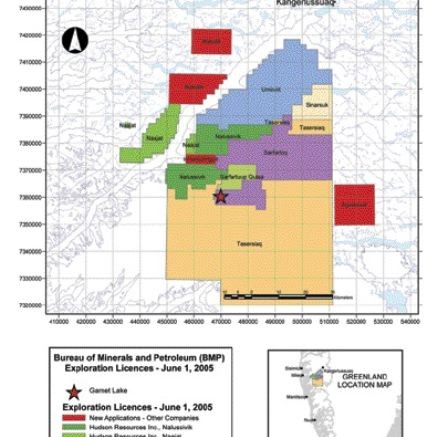Vancouver —
The Vancouver-based junior has an option to acquire an 80% interest in Perth-based
Situated in southwestern Greenland, the area is thought to be underlain by the same Archean craton that hosts most of the major diamond discoveries in Canada.
Hudson sprang into action last fall after several macrodiamonds were recovered from what appeared to be frost-heaved kimberlite at Garnet Lake. A 108-kg sample of varying phases of ultramafic eruptive yielded an impressive 150 diamonds, of which nine were macros (deemed to be equal to, or greater than, 0.5 mm in at least one dimension) weighing a total of 0.088 carat, along with several large garnets.
Hudson set out to find the bedrock source of the diamondiferous kimberlite, thought to be underneath the boulders. The company started with a 40-line-km ground electromagnetic and magnetic survey over prospective areas at Garnet Lake.
Crews drilled six shallow holes spaced 100 metres distant to depths of 60-100 metres below surface. Drilling intersected kimberlite consisting of steeply dipping stacked dykes with crosscutting sills. Some nine kimberlite intercepts, averaging 0.78 metre in width, were recovered in each hole. The widest was a near-surface intercept with a true width of roughly 3.9 metres. What’s more, kimberlite indicator minerals on surface suggest the kimberlite body could extend another 3 km.
The company believes that the Garnet Lake kimberlitic complex could represent the top of a kimberlitic system, as indicated by the abundance of dykes and sills.
Hudson President James Tuer says geophysics has proven less than helpful in outlining drill targets. “It is a noisy basement environment — magnetic highs and lows are just not reliable,” Tuer explains.
While Tuer is disappointed with the absence of kimberlite pipes, he remains hopeful. “Diamond exploration is tricky and in this case the rewards far outweigh the risks,” says Tuer. “Besides you don’t need a pipe to make the economics work if the diamonds are there, just look at Snap Lake.”
The company takes comfort in knowing that the core contains numerous pyrope-coloured and eclogite-coloured garnets. Indeed, the core looks similar to kimberlite float that yielded diamonds during summer 2004 exploration.
Core from Garnet Lake is undergoing analysis for diamonds and indicator minerals at the Saskatchewan Research Council labs. Results should be known by the end of June.
Although only a 40-kg sample was available for analysis (in an effort to be consistent with the surface boulders), it would have to yield somewhere between 40-60 diamonds, among which Hudson is hoping for 3 or 4 macros.
Six of seven holes drilled 700 metres north, 700 metres northeast, and 1,400 metres east of Garnet Lake, intersected kimberlites up to 2.74 metres in thickness. Of note, seven metres of competent kimberlite was recovered in 65 metres of core in a hole testing a prominent magnetic low. The kimberlite material carries mantle nodules similar to ones found at surface.
Although the region is known to host sulphide deposits, Hudson was surprised to learn its final hole cut 26.6 metres of sulphide-bearing ultramafic rock while testing a magnetic high. Results of the metal analyses are pending.
Meanwhile, 9 km east of Garnet Lake, crews drilled three holes into an electromagnetic target on Spider Lake, and another three onshore, to test a magnetic target coincident with diamondiferous samples on surface.
The lake-based drilling intersected a series of shallow-dipping sills up to 1.7 metres in thickness, and averaged 28 kimberlite intercepts of 0.24-metre in width. Onshore drilling proved to be more hit-and-miss with each hole cutting eight intercepts of up to 3.66 metres in width.
The company wants to expand the 25-sq.-km area at Garnet Lake containing the highly anomalous indicator minerals. Another 500 metres of drilling is slated for land targets during the summer field season. Follow-up drilling at Garnet Lake will get the go-ahead once the lab results are in. Hudson is anxious to test a large “massive sulphide style” conductor found south of Spider Lake.
Hudson expects to vest its interest in Sarfartoq by the end of June after completing its work commitments. The company has spent about $1.7 million exploring the property over the previous three years.
Greenland has seen several waves of diamond exploration. In the 1990s, several major exploration companies on the trail of the next Voiseys Bay recognized the region’s potential for diamonds. A few explorers conducted extensive sampling programs and acquired prospective ground. But by the end of the decade exploration capital was drying up and much of the ground was abandoned.
In 2002, Tuer, an engineer and investment banker, armed with advice from diamond expert John Ferguson, arrived on the scene. Ferguson, via Citation Resources, was no stranger to diamond exploration in Greenland having worked with famed diamond-discoverer Charles Fipke, best known for finding Ekati, Canada’s first diamond mine.
Tuer took a high-tech shell, changed its name to Hudson Resources, and launched the search for Greenland gems. The company started with Sarfartoq because it showed good kimberlite indicator mineral geochemistry, came with a dataset reminiscent of Canada’s Lac de Gras region, and contained highly diamondiferous kimberlitic boulders. With Greenland’s political stability, set mineral tenure and lack of native land claims issues, Hudson didn’t have to think twice about securing ground in the area.
Conveniently enough, Hudson’s ground sits next door to property where high concentrations of G10 garnets were found by Fipke’s


Be the first to comment on "Hudson confirms kimberlite at Garnet Lake in Greenland"